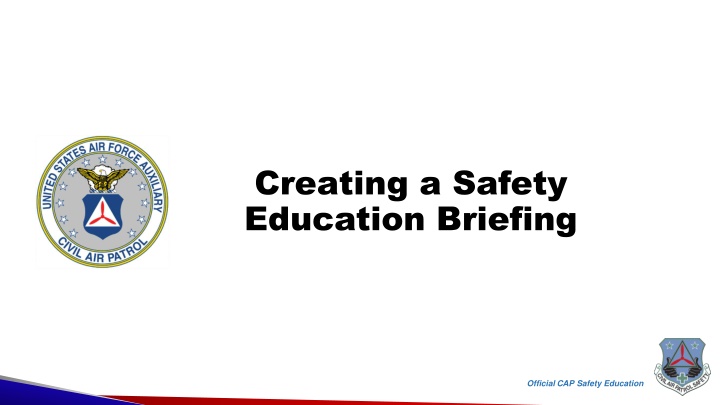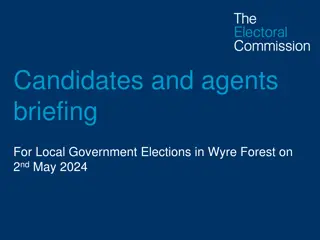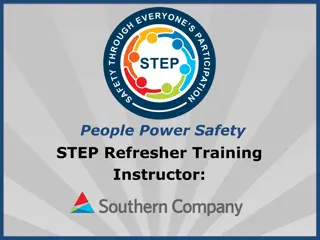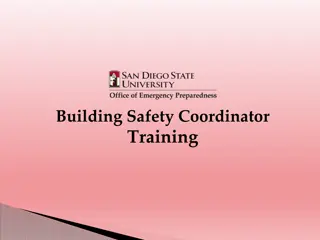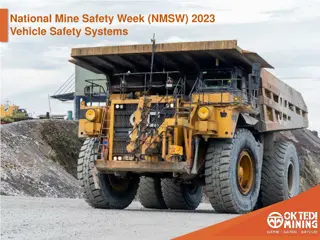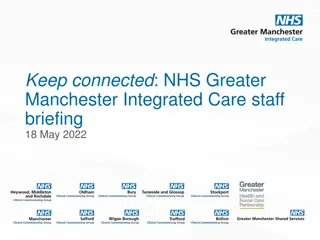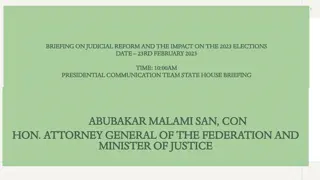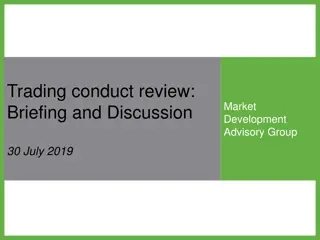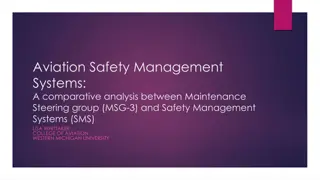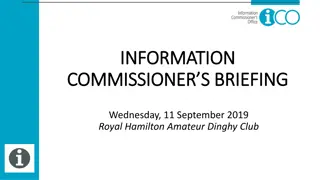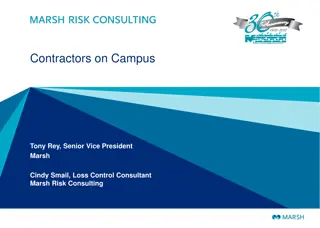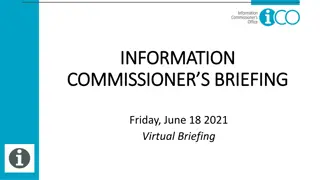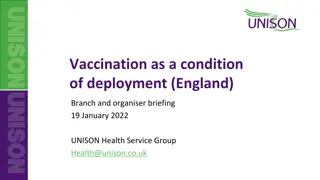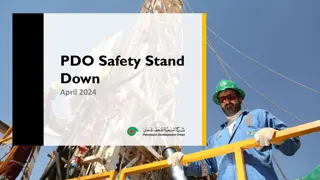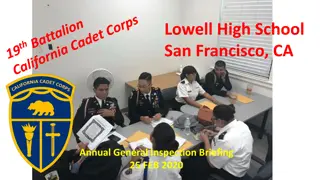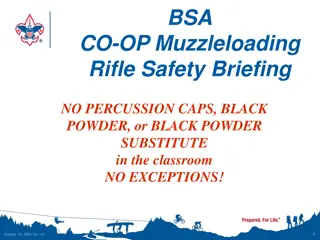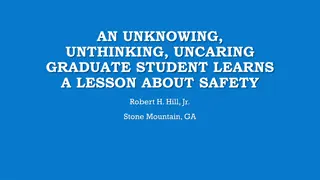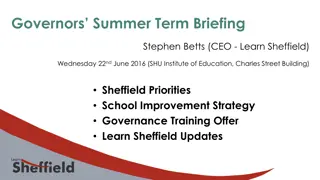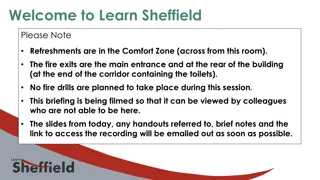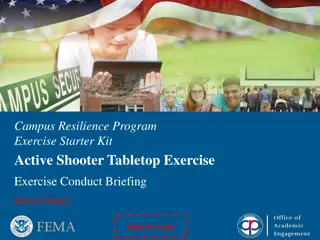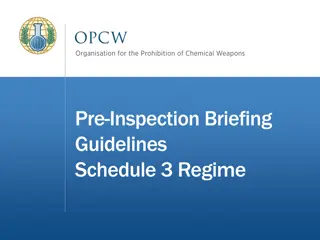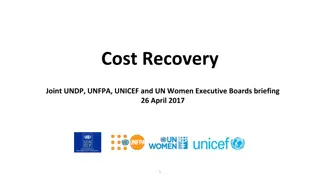Building an Effective Safety Education Briefing
Building an effective safety education briefing is crucial for reinforcing understanding of risk management among Civil Air Patrol members. This course guides you in selecting a topic, conducting research, developing briefing slides, and using the Safety Briefing Template. Focus on CAP activities, local hazards, unit activities, seasonal topics, and current events to engage in open discussions on safety and risk management.
Download Presentation

Please find below an Image/Link to download the presentation.
The content on the website is provided AS IS for your information and personal use only. It may not be sold, licensed, or shared on other websites without obtaining consent from the author.If you encounter any issues during the download, it is possible that the publisher has removed the file from their server.
You are allowed to download the files provided on this website for personal or commercial use, subject to the condition that they are used lawfully. All files are the property of their respective owners.
The content on the website is provided AS IS for your information and personal use only. It may not be sold, licensed, or shared on other websites without obtaining consent from the author.
E N D
Presentation Transcript
Creating a Safety Education Briefing Official CAP Safety Education
The Safety Education Brief Building a Safety Education Briefing? Where do you start? What do you need? This course will guide you through the process ONE CIVIL AIR PATROL / EXCELLING IN SERVICE TO OUR NATION AND OUR MEMBERS
The Safety Education Brief Here s what we ll learn The purpose of the safety education briefing Selecting the topic Finding your sources and doing your research Developing your briefing Creating your briefing slides Using the Safety Briefing Template! ONE CIVIL AIR PATROL / EXCELLING IN SERVICE TO OUR NATION AND OUR MEMBERS
Safety Education Content CAPR 160-1, paragraph 5.2.1.1. Monthly Safety Education Reinforce CAP members understanding of risk management Should include discussion of hazards, risks, risk controls, and risk planning in the context of CAP s unique missions and activities THIS means your briefing should focus on CAP activities Local hazards, unit activities, seasonal topics, missions, current events Topics that lend themselves to an open discussion of safety and RM ONE CIVIL AIR PATROL / EXCELLING IN SERVICE TO OUR NATION AND OUR MEMBERS
Selecting Your The Topic Topic selected for you: Your commander assigned you to brief on a certain topic? Make sure you understand what they expect What are they most concerned about? You need to find a topic: Looking for something new to brief? Ask for suggestions from members in your unit Look at upcoming activities, missions, seasons, holidays Current events ... examples of risks and how they re controlled ONE CIVIL AIR PATROL / EXCELLING IN SERVICE TO OUR NATION AND OUR MEMBERS
The Topic Important Advice! Keep it Short! Most topics should be covered in less than 15 minutes You should usually be able to cover it in ten or fewer slides (not counting the intro, the cover, the final slide, etc.) If it takes longer than that, your topic is probably too broad Stay on the Subject Allow for discussion ONE CIVIL AIR PATROL / EXCELLING IN SERVICE TO OUR NATION AND OUR MEMBERS
Outline Your Briefing Introduction and Background Give some history or background information What kind of event, activity, or risks are you talking about? Can you tie it in with CAP activities or missions? Risks at home? Why did you decide to talk about this topic? Attention Step Why should your audience be interested in this topic? Will this briefing help them perform their mission? Will it avoid a common injury? Will it help prevent a common mishap? ONE CIVIL AIR PATROL / EXCELLING IN SERVICE TO OUR NATION AND OUR MEMBERS
Outline Your Briefing Hazards, Risks, and Controls Remember there are two purposes of monthly safety education Teach and reinforce knowledge about risk management processes Teach RM in the context CAP missions and activities Show how RM process is a part of mishap prevention Use the same processes and terminology we see in CAPR 160-1 Reinforce a universal CAP-wide standard for RM Two options for discussing your topic ONE CIVIL AIR PATROL / EXCELLING IN SERVICE TO OUR NATION AND OUR MEMBERS
Outline Your Briefing Hazards, Risks, and Controls Different briefing techniques can be used for different topics: 1. List all the hazards and risks, then talk about the controls You can talk about all then things that can go wrong Then you can talk about how a good plan will reduce those risks 2. Show each risk separately discuss how to control each risk Review the topic and lead a what if discussion invite participation Promotes a step-by-step team approach to risk management ONE CIVIL AIR PATROL / EXCELLING IN SERVICE TO OUR NATION AND OUR MEMBERS
Outline Your Briefing Risk Controls Be specific good discussion areas for the group: What works best for controlling each risk? How would a person actually use these risk controls? How will you know the risk controls are working? What do you do if the risk control isn t working as planned? Make risk controls part of the plan: Risk control steps are part of the checklist not an add on ONE CIVIL AIR PATROL / EXCELLING IN SERVICE TO OUR NATION AND OUR MEMBERS
Outline Your Briefing Hazards, Risks, and Controls Let s review a little . Think about which method you d use to talk about preparing for a hurricane? teach members how to avoid dehydration? remind members about the hazards of distracted driving? discuss risks associated with holiday vacations and celebrations? ONE CIVIL AIR PATROL / EXCELLING IN SERVICE TO OUR NATION AND OUR MEMBERS
Research/Credibility It is VERY important to use reputable sources and provide verified information in Safety Education briefings!!! Research your topic and provide references Give references for each statement, or list sources at end of briefing This ensures members are receiving accurate information Avoid spreading rumors, opinions, or old wives tales Select a reputable source that is appropriate for your topic Medical topics? Use AMA, Mayo Clinic, NIH, CDC, hospitals, etc. Vehicle safety? NHTSA, AAA, DOT, Insurance companies, etc. General safety topics? OSHA, Nat Safety Council, AF Safety Center CAP Topics? Quote the regulations or other sources ONE CIVIL AIR PATROL / EXCELLING IN SERVICE TO OUR NATION AND OUR MEMBERS
Borrow but Give Credit It is okay to borrow slides, videos, or charts from experts It ensures members receive correct information It makes it clear that you re quoting the experts rather than implying that you are the expert on this particular subject Give them credit, by name, for the material you use Provide links for further information Don t put your name or CAP s name on their material ONE CIVIL AIR PATROL / EXCELLING IN SERVICE TO OUR NATION AND OUR MEMBERS
Designing Your Slides Choices Use the Template on the CAP Safety pages (gocivilairpatrol.com) Easy to use guide on Safety Education Resources page Type right over the words on the template Use your unit design, or create your own This briefing includes a lot of things you should do Check out the following pages for things you shouldn t do ONE CIVIL AIR PATROL / EXCELLING IN SERVICE TO OUR NATION AND OUR MEMBERS
Dont Don t use long paragraphs or too many words! If you have a paragraph like this in your briefing, either no one is going to read it, or everyone will be reading it and they will ignore whatever it is you are saying. Even if you want to show what is written in a regulation, you can paraphrase it in a few small bullets and then the members can look up the regulation when you are through with your briefing. If you are going to have a paragraph like this on a slide you might as well just print out a word document and hand it to them. Actually, that might be a good idea! In short, a long paragraph like this is not a good thing to have in any briefing if you want people to pay attention. Do! Use short bullets instead of big paragraphs Feel free to provide a handout they can take with them ONE CIVIL AIR PATROL / EXCELLING IN SERVICE TO OUR NATION AND OUR MEMBERS
Dont Don t get too fancy with the fonts and colors Using fancy or light-colored fonts in a darker colored background can be very hard to read. It is better to just use a white or very light background, with a black or dark font, so the slides are easy to read and don t detract from the message. Do! Make it easy on everyone stick with black on white type ONE CIVIL AIR PATROL / EXCELLING IN SERVICE TO OUR NATION AND OUR MEMBERS
Dont Don t name names Don t use specific names or units when discussing mishaps Don t tell stories about people, no matter how harmless they sound Do! Provide hypothetical situations or what if examples to illustrate the risks ONE CIVIL AIR PATROL / EXCELLING IN SERVICE TO OUR NATION AND OUR MEMBERS
Dont Don t use the CAP Safety patch or the CAP official seal Using either of these patches implies the briefing is produced by, and speaks for, National Do! Use your unit or wing patch with your commander s approval ONE CIVIL AIR PATROL / EXCELLING IN SERVICE TO OUR NATION AND OUR MEMBERS
Summary Pick a topic related to you mission, your activities, your members Discuss the hazards, the risks, and the risk controls Rely on the experts for your facts and training Encourage discussion and questions from everyone Share you briefing! send a copy to safety@capnhq.gov ONE CIVIL AIR PATROL / EXCELLING IN SERVICE TO OUR NATION AND OUR MEMBERS
